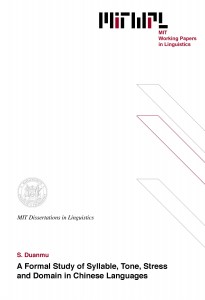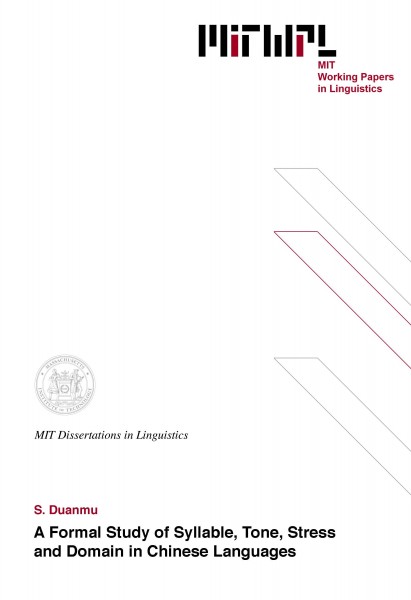A Formal Study of Syllable, Tone, Stress and Domain in Chinese Languages
S. Duanmu, 1990
This thesis makes a close examination of syllable, tone and stress in Chinese languages, in order to find out general properties that are shared by all natural languages. It offers the following related claims.
(1) All Chinese syllables have the following uniform underlying structure
![]()
![]() s
s
![]()
![]()
![]() O R
O R
X X X
(2) The general tonal model is as follows
Laryngeal Root
/ \ / \
V/R Pitch Laryn …
/ \ / \
[st] [sl] [above] [below]
where the tonal structure is part of the feature geometry under a Root node. The
V/R node represents both consonant voicing and tonal register. The Pitch node is
specified for tone bearing segments only.
(3) The tone bearing unit is the moraic segment, or equivalently, the segment in the
rime, whether it is a vowel or any consonant. A geminate has two Roots and may
serve as two tone bearing units.
(4) Contour segments do not exist. Their absence is attributed to a universal
principle, the No Contour Principle (NCP), which is given as follows.
*X
/ \
[aF] [-aF]
(5) The tonal domain is the stress domain. Most syntax-phonology mismatches are
due to lack of stress in some constituents.
Thesis Supervisor: Morris Halle
Title: Institute Professor
Table of Contents
Chapter 1 Outline 8
Chapter 2 Syllable 17
2.0 Introduction 17
2.1 The syllabic structure of Chinese Languages 18
2.1.1 Mandarin 18
2.1.1.1 Obligatory ‘zero onset’ 19
2.1.1.2 Prenucleus G is in the onset 25
2.1.1.3 The onset has one slot 30
2.1.1.4 The rime has two slots 33
2.1.1.5 Summary 34
2.1.2 Shanghai 37
2.1.3 Meixian (Moi-yan) 39
2.1.4 Xiamen (Amoy) 41
2.1.5 Fuzhou 42
2.1.6 Cantonese 47
2.1.7 Changsha 51
2.1.8 Nanchang 52
2.1.9 Summary 52
2.2 Suffixation and rime changes 53
2.2.1 The Mandarin [r] suffix 53
2.2.2 The Chengdu [r] suffix 59
2.2.3 Jiyuan 59
2.2.4 Yanggu 64
2.2.5 Heshun 66
2.2.6 Summary 68
2.3 Language Games (Fanqie Languages) 68
2.3.1 Na-ma 69
2.3.2 Mai-ka 71
2.3.3 Mo-pa 72
2.3.4 Summary 74
2.4 Cooccurence restrictions on labials 75
2.4.1 Mandarin 78
2.4.2 Cantonese 80
2.4.3 Taiwanese 84
2.4.4 Summary 88
2.5 Some theoretical implications 89
2.5.1 V/C segregation 89
2.5.2 The moraic theory 92
2.5.3 Summary 96
Chapter 3 Tone 98
3.0 Introduction 98
3.1 The representation of tone 102
3.1.1 Chao letters 103
3.1.2 Halle & Stevens (1971) 107
3.1.3 Kingston & Solnit (1988) 111
3.1.4 Yip (1980) 115
3.1.5 Yip (1989a) and Hyman (1989) 115
3.1.6 Bao (1989) 117
3.1.7 Bao (1990a) 118
3.1.8 The present model 118
3.1.8.0 Too many contrasts? 121
3.1.8.1 Spreading 122
3.1.8.2 Translation from Chao letters 124
3.1.8.3 The Mon-Khmer register and tonogenesis 125
3.1.8.3.1 The Mon-Khmer register 125
3.1.8.3.2 Enhancement 127
3.1.8.3.3 Tonogenesis 128
3.1.8.4 Tone split and depressor consonants 129
3.1.8.5 Blocker consonants 131
3.1.9 Summary 132
3.2 Tonal ‘flip-flop’ 133
3.3 Consonant TBU and the Ru syllable 136
3.4 Contour Tone Unit (CTU) 138
3.4.1 Free Occurrence 139
3.4.2 The OCP 139
3.4.3 CTU spreading 140
3.4.3.1 Danyang 140
3.4.3.2 Changzhi 145
3.4.3.3 Wenzhou 147
3.4.4 Summary 148
3.5 Tone Bearing Unit 149
3.6 How many tones can a TBU bear? 153
3.7 The theory of contour features 158
3.7.1 Affricates 158
3.7.2 Pre- and post-nasalized stops 161
3.7.3 The No Contour Principle (NCP) 170
3.7.3.1 Association conventions 170
3.8 Summary 172
Chapter 4 Stress 173
4.0 Introduction 173
4.1 Halle & Vergnaud (1987) 173
4.2 Halle (1989) 173
4.3 Syntactic information and nonhead stress 173
Chapter 5 Domain 181
5.0 Introduction 181
5.1 Mandarin 181
5.2 Shanghai 184
5.3 Syntax-phonology mismatches 189
5.3.1 Shanghai 190
5.3.2 Mandarin T3S 193
5.4 Summary 196
References 197

